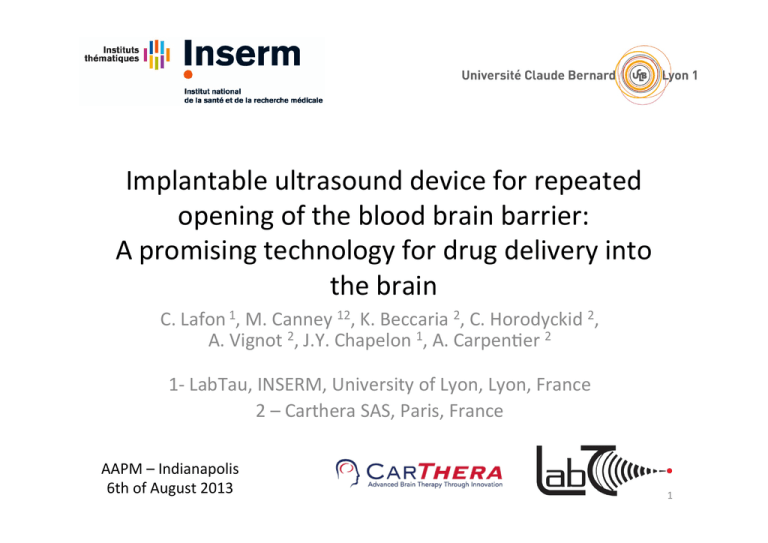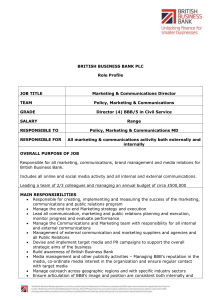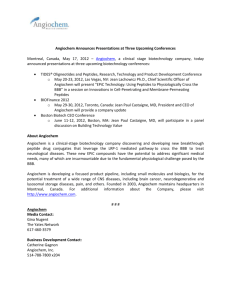Document 14206310
advertisement

Implantable ultrasound device for repeated opening of the blood brain barrier: A promising technology for drug delivery into the brain C. Lafon 1, M. Canney 12, K. Beccaria 2, C. Horodyckid 2, A. Vignot 2, J.Y. Chapelon 1, A. CarpenGer 2 1-­‐ LabTau, INSERM, University of Lyon, Lyon, France 2 – Carthera SAS, Paris, France AAPM – Indianapolis 6th of August 2013 1 Brain tumors = a drama.c prognosis • Why ? The blood-­‐brain barrier (BBB) limits the efficacy of chemotherapy • US demonstrated to induced BBB opening in pre-­‐clinical studies using pulsed ultrasound + US contrast agents – Skull is main problem for clinical applicaGon – MRguided Extracorporeal US Phased Arrays (McDannold et al. 2012, Cancer Research, …) – Heavy method for rouGne repeated BBB opening at each chemotherapy session Figure from Vykhodtseva et al. (2008) Original concept Use skull burr hole (1-­‐cm) a_er tumor resecGon for an implantable ultrasound device to achieve simple, repeated BBB openings Implantable US Device: Concept! 1. 1 MHz, 10 mm diameter transducer" 3. External Generator" 2. Transdermal needle connection" 1. Ultrasound device is implantable, MR-compatible, no energy source" 2. Power supplied by needle connection" " 3. External generator used for USactivation and treatment control" Preclinical trials – Short term safety! Rabbits" Beccaria et al. Journal of Neurosurgery 2013" Toxicity a_er 7 days evaluated a_er BBB opening. Dogs" No adverse effects observed on MR and histology. No behavior modification. " MR at day 7 showed normal BBB." Previous pre-clinical studies show safety of BBB opening protocol in short-term (0-7 days) with single sonication/opening" Preclinical trials – Drug delivery • Experiments in rabbits • Opening of the BBB with US 5 minutes after injection of chemotherapy Irinotecan +206% Temozolomide +20% Goal of the present study • Perform repeated (7 times) BBB opening" • Evaluate long term safety and toxicity " • in primates Experimental protocol • 3 primates (2 baboons and 1 macaque) " • Protocol:" – Implantable ultrasound device on top of motor cortex in a typical neurosurgeon’s burr hole" – Repeated BBB openings every 2 weeks during 3 months (7 BBB opening sessions)" • Follow up" – Contrast enhanced MRI" – Electrophysiology" – PET" – Histology" Exposure condi.ons • Transdermal electrical supply at each session" • Flat piston, 1 cm in diameter, 1 MHz" • 0.6-0.8 MPa, 25 ms pulse, 1 Hz (DC=2.5%), 120 s " • SonoVue (0.1 cc/kg)" Simulated pressure field in water Monitoring with T1-w contrast-enhanced MRI ! BBB opening observed immediately after each sonication" Electrophysiologic monitoring Before and a_er each BBB opening session • Electro-­‐Encephalogram • No epilepGc signs (foci, ii-­‐spike) • No cogniGve decline • No medicinal encephalopathy • Somatosensory Evoked PotenGals • No pathologic conducGon • No amplitude modificaGon ►► No neural hyper excitability ►► No neural conducGon abnormality FDG18 / glucose uptake PET monitoring Day 0 Day 1 Day 45 Day 60 Day 75 (n=15, after BBB opening) ►► PET scans showed no significant changes in cerebral metabolism of glucose DPA714 PET monitoring • At D7 post BBB opening ►► No significant inflammaGon at 7 days post US/BBB opening Behavior & Neurological status • n=3x16: baseline, before and a_er 7 sonicaGons, endline • BBB opening was performed in the primary motor cortex ►► Normal Behavior in all 3 animals during the 4 months ►► Normal motricity neurological status Histology H&E at month 4 No signs of hemorrhagic processes or ischemia Histology Glut 1 at month 4 • Integrity of the vessel walls was unchanged. • ExtravasaGon of a few red blood cells in 1 primate though not observed on MRI. Conclusions SonoCloud® : an promising (efficient and safe) implantable ultrasound device developed for repeated BBB opening on clinical routine patients" • Work supported by CarThera SAS CEA Orsay : Raphaeal Boisgard, Geraldine Pomer Electrophysiologist : Pr Willer and Dr Huberfeld Radiologist : Dr Drier Brain & Spine InsGtute Histopathology : Annick Prigent, Pr Clovis Adam • Brain & Spine InsGtute MRI and veterinary teams. • • • •


